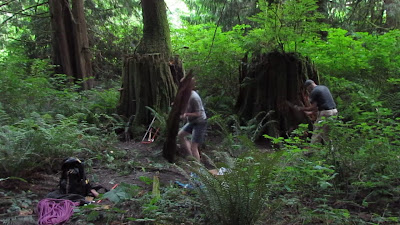"A" and I come up in the evening. She has had an art installation out in the forest for about 2 years - several old law books, carved and sealed in wax, but with a couple fungi types introduced to the pages. They were mounted on the sides of old growth cedar nurse stumps. We're collecting them to be shown back in the city. I had suggested that we split out part of the stumps, so we come armed with a saw, axe and some rope.
Philosophy Camp is getting started up at the house (another of the annual Smoke Farm events), but we just wave as we pass, stopping only to talk to "B" because he is on the road as we go in. We both think it is best to not disturb the philosophers.
The forest is already taking on the damp of the evening, it is such a good smell.
There are more of the wax blocks than I had thought. "A" has them on four different stumps, but all in the same area. We figure that these trees were turned into stumps before 1900. This is low land and not too far from the Salish Sea, so it would've been logged early and lasted longer only by chance. There are some 2nd growth of 2 to 3 ft diameters growing from some of the stumps.
What is surprising, as we work, is the variation in the wood in the stumps. Some of it is quite rotten with a earthy smell of composting wood and organisms while large portions are still solid and firm. The axe plunges through the former, but bites firmly into the latter. I find out that the splitting off of the firm sections will take more time than we have, the sun beginning to set in a forest valley that doesn't see that much sunlight anyway. But we find and pull free some 5ft slabs that were laying on rotting wood. "A" finds that one of the fungi is finally growing on one of the wax blocks.
 |
| A dances with an aged slab of western red cedar |
We carry the wood back to the car. The smell of the forest rebuilding itself gets rubbed into our clothes. It stays with us in the car as we talk about art, politics, life...as we talk about how we rebuild ourselves.




